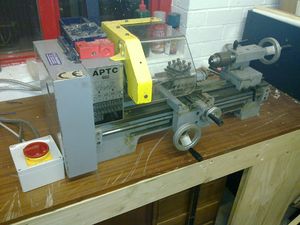Lathe: Difference between revisions
Jump to navigation
Jump to search
No edit summary |
|||
| Line 11: | Line 11: | ||
Our lathe is suitable for turning metals and plastics. Aluminium, brass, copper, delrin/acetal and nylon shouldn't present any problems. It should be possible to machine mild steel too, though you may find some additional cooling is necessary. | Our lathe is suitable for turning metals and plastics. Aluminium, brass, copper, delrin/acetal and nylon shouldn't present any problems. It should be possible to machine mild steel too, though you may find some additional cooling is necessary. | ||
== Safety == | |||
*Always ensure the chuck key is removed before attempting to operate the lathe. | |||
*Ensure the work is securely fixed in the chuck. | |||
*The lathe will not run unless the guards are in place - this is for your safety, do not try to defeat this. | |||
*Swarf is '''SHARP''' - gloves are available in the box by the lathe. | |||
*Don't attempt to start drilling holes with a normal drill in the tailstock chuck - use a centre drill to create a pilot hole first. | |||
*Go and check you removed the chuck key again. | |||
Revision as of 10:01, 30 November 2012

The Basics
We've got an APTC 460 lathe. Vital statistics are as follows:
- 1.5hp motor
- 250/650/900/1700 RPM
- 100mm chuck
- 460mm between centers
- MT2 tailstock (currently fitted with a 13mm drill chuck)
Our lathe is suitable for turning metals and plastics. Aluminium, brass, copper, delrin/acetal and nylon shouldn't present any problems. It should be possible to machine mild steel too, though you may find some additional cooling is necessary.
Safety
- Always ensure the chuck key is removed before attempting to operate the lathe.
- Ensure the work is securely fixed in the chuck.
- The lathe will not run unless the guards are in place - this is for your safety, do not try to defeat this.
- Swarf is SHARP - gloves are available in the box by the lathe.
- Don't attempt to start drilling holes with a normal drill in the tailstock chuck - use a centre drill to create a pilot hole first.
- Go and check you removed the chuck key again.